Strategy, Legal & Operations
How process manufacturers can tackle regulatory change
Process manufacturers are being affected by global trends such as Brexit and the USMCA free trade agreement, according to results in a new survey.

Global trade is never out of the headlines. In the UK, the implementation of a likely Brexit and how manufacturers can deal with it has dominated news pages, while the same has been seen in the US with the impact of tariffs and an ongoing trade war between the US and China.
But what’s the reality?
There are numerous stories about the state of the global manufacturing industry but what’s actually happening? How has regulatory change affected the business plans of process manufacturers, and if it has, what kind of steps have they been taking to mitigate the effects of global upheaval?
To answer these questions, Sage conducted research by questioning 900 professionals from mid-sized process manufacturers in the UK and US, which make products such as food, drink, gasoline, oil and plastics.
The responses revealed interesting insights into how the likes of the UK preparing to leave the European Union (EU) and the United States-Mexico-Canada Agreement (USMCA) trade deal have affected them, what they were doing to take advantage of opportunities, and how they are approaching any threats to come.
Impact of regulatory change
Our research reveals 62% of UK process manufacturers are being affected due to their need to prepare for regulatory change. This is a high figure, and is much to do with due to Brexit talks, which have only increased business uncertainty since the UK voted, in June 2016, to leave the EU.
Changes to import and export conditions have affected the decision making of process manufacturers, with 96% saying they will have an impact.
Meanwhile, 32% of UK process manufacturers say they are having a very high impact on their strategic decision-making, while 50% state they will have a high impact.
Manufacturers have had to understand how various Brexit and USMCA scenarios would could affect their supply chains and the movement of goods including:
- Tariff exposure and other costs.
- Compliance – irrespective of any deals made (such as free trade agreements between the UK and EU or the US and China) or a no-deal Brexit (and the transition to World Trade Organisation rules) goods will need to be declared, with custom procedures applied and opportunities for tax/duty planning.
- Relationships with suppliers – if manufacturers rely on certain components, understanding how this will work will be a priority as lead times may increase.
- The security of customer relationships and the effect on demand volume, contract terms, pricing and rebates.
- The potential loss of research and development grants, and the impact on product marketing and procurement.
UK manufacturers will have prepared by examining their supply chains closely, taking care to understand where delays may potentially hit the business and asking their suppliers about their own plans for regulatory disruption.
They may have applied to become an Authorised Economic Operator (AEO) – an accreditation that allows businesses to register to apply simplified customs procedures to fast-track their goods through customers border controls, providing assurance to HMRC that their import/export practice is secure.
However, supply chain strategies shouldn’t have been just be about mitigation.
Forward-thinking manufacturers will have been looking at challenging the status quo in their supply chains and seeing how things could work differently, through, for example, reducing lead times and deferring the time when any duties need to be paid.
Thinking differently, thinking local
With regulatory change presenting challenges when it comes to international trade, the research revealed that manufacturers are looking at the value of product created locally and the associated onshoring possibilities.
In the UK, the figures suggest manufacturers believe “Brand Britain” holds sway with global customers.
They see a business opportunity in creating local, artisan goods with higher prices than goods that were cheaper due to mass production or cheaper raw materials. They understand that being made in Britain can be regarded as a badge of quality, even if it is priced higher.
In the food and beverage manufacturing industry, an increasing demand for craft beer is a good example of consumers moving away from dominant international beer brands and towards newer home-grown craft beer products.
This taps into the British pint drinker’s love of variety, better quality, and a passion for brands with local provenance.
One of the most high-profile examples of this in the past few years is Brewdog, which was founded in Ellon in Scotland, where its beer is still brewed.
In addition, consumers might want to support their local economy, reduce environmental impact with goods that don’t need to be shipped globally, and in food and beverage manufacturing, understand the provenance of what they buy.
This trend for local products isn’t just tied to food and beverage.
In the UK, US and Canada, 59% of chemical manufacturers also saw customer demand for locally produced goods and value in not having to cross international boundaries where currency fluctuations could impact their profit margins.
It certainly shows an opportunity for new suppliers and partners to emerge, which could dramatically alter international and domestic sourcing strategies and supply networks.
Read more about manufacturing
- How blockchain traceability can improve supply chain management
- A report on how process manufacturers are planning for a brighter future
- Onshoring: Should manufacturers bring business closer to home?
- How servitisation can help manufacturers win more business
Turning towards technology
With regulatory change ahead for UK manufacturers, are they tightening budgets and holding spending back, or are they investing in solutions to mitigate any negative effects?
According to our research, uncertainty makes process manufacturers more likely to invest in new technology.
The message here seems to be clear. Many manufacturers are already investing in strong, digitised global trade and supply chain solutions, which means that those who don’t could be left behind and playing catch up once regulatory change comes into fuller effect.
Bryan Ball, research director for Supply Chain and Supplier Management at research firm Aberdeen, has some words of advice for manufacturers that have not as yet embarked on a digital transformation plan to prepare for changes, or were confused about what to do.
He says: “Having access to the latest global trade data to make informed decisions is the starting point. With the potential changes that may be coming, keeping up with the volume of new trade agreements alone may be a show stopper for some companies without proper access to trade data.”
What kind of technology should manufacturers be looking to invest in? A good guide to answering this question is by looking at what technologies are in maturity in the businesses Sage questioned.
This focus on enterprise resource planning (ERP) or business management solutions should be expected, but it’s encouraging to see a shift towards emerging technologies, with artificial intelligence, automation, robotics, and even blockchain already in use or with plans to be used in the near future.
This shows that Industry 4.0 is more than a concept – with a large majority of manufacturers choosing to take advantage of the gains it can make in terms of productivity and efficiency, even if it does require significant investment.
Tips to deal with policy changes
To deal with anticipated trade and tax policy changes, here are three tips for your manufacturing firm to put into practice:
1. Track delivery performance and trade data
Establish the starting point by measuring and tracking delivery performance, compliance costs, and total landed cost increases. You might need to consider faster or more frequent deliveries, as well a volatility in the cost of international freight and fuel surcharges.
You will also need to access up-to-date global trade information, which ensures you aren’t “flying blind”.
Having visibility of all international events and information on new trade agreements is critical to managing on-time performance and taking advantage of new opportunities.
2. Accommodate for changes in supplier
Recognise and prepare for the influx of upcoming changes by performing an internal assessment of capability gaps.
Your business will need the ability to adjust data and accommodate changes to your supplier base. You can’t do this if you have a manual, static operation, so you’ll need the right processes and technology to take advantage of opportunities when they arise.
In terms of technology adoption, you might have in-house solutions that can be tough to replace, so you may choose a programme of modification.
However, you might also look at new technology solutions, or lean on the capabilities of a partner or third-party technology. Automation and connectivity, for example, can provide real-time trade event monitoring.
3. Add the right staff and pick the right partners
You might need to onboard staff and bring resources in-house to ensure better trade compliance. This may take time and may cost more than your allotted budget, so you should look at bringing in selected valued partners and external expertise to minimise further performance loss.
You might also look at working with vendors such as forwarders, carriers and brokers.
Riding the wave of uncertainty
What does regulatory change mean for process manufacturing? Read this report to learn how manufacturers are tackling challenges and focusing on growth – and see how you can too.







Ask the author a question or share your advice